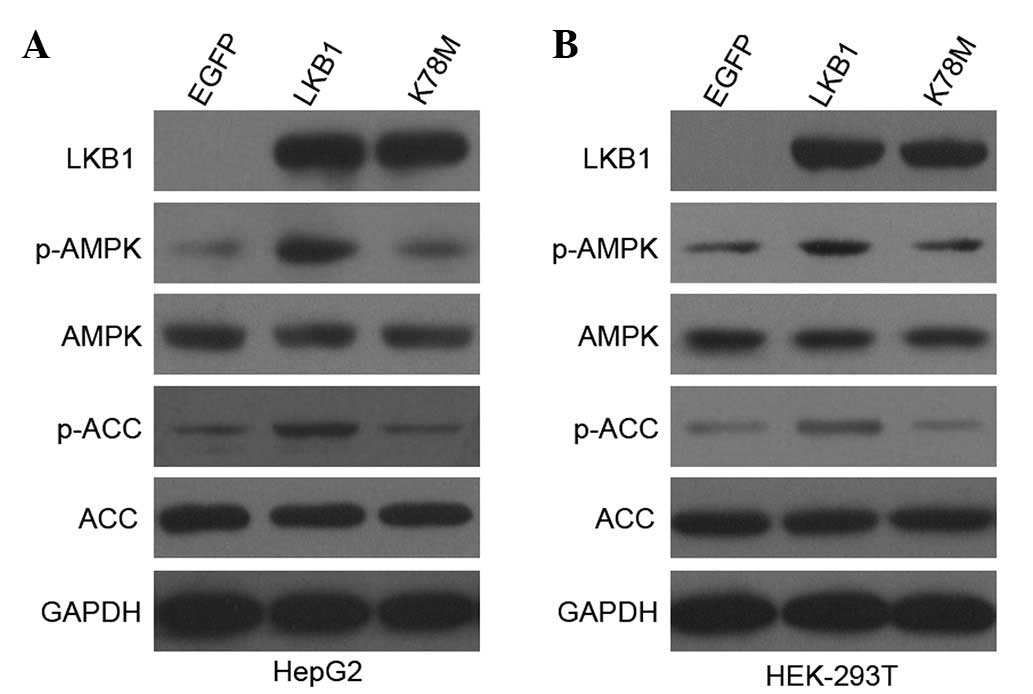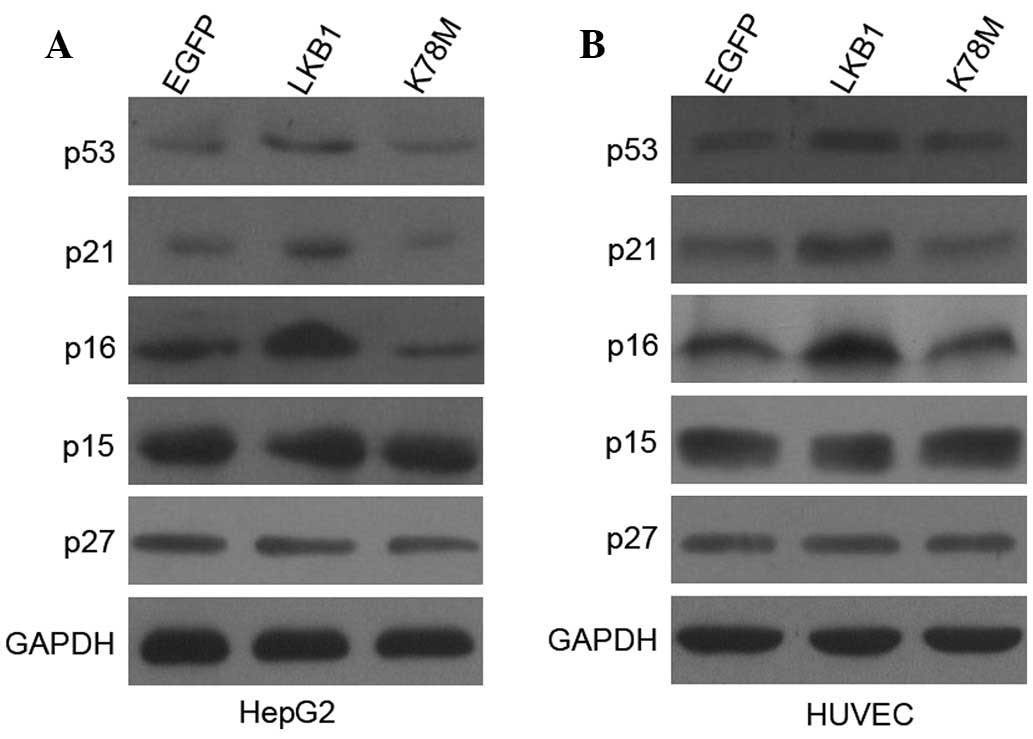|
1
|
McGarrity TJ and Amos C: Peutz-Jeghers
syndrome: clinicopathology and molecular alterations. Cell Mol Life
Sci. 63:2135–2144. 2006. View Article : Google Scholar : PubMed/NCBI
|
|
2
|
Rustgi AK: The genetics of hereditary
colon cancer. Genes Dev. 21:2525–2538. 2007. View Article : Google Scholar : PubMed/NCBI
|
|
3
|
Hemminki A, Markie D, Tomlinson I, et al:
A serine/threonine kinase gene defective in Peutz-Jeghers syndrome.
Nature. 391:184–187. 1998. View
Article : Google Scholar : PubMed/NCBI
|
|
4
|
Jenne DE, Reimann H, Nezu J, et al:
Peutz-Jeghers syndrome is caused by mutations in a novel serine
threonine kinase. Nat Genet. 18:38–43. 1998. View Article : Google Scholar : PubMed/NCBI
|
|
5
|
Williams T and Brenman JE: LKB1 and AMPK
in cell polarity and division. Trends Cell Biol. 18:193–198. 2008.
View Article : Google Scholar : PubMed/NCBI
|
|
6
|
Shackelford DB and Shaw RJ: The LKB1-AMPK
pathway: metabolism and growth control in tumour suppression. Nat
Rev Cancer. 9:563–575. 2009. View
Article : Google Scholar : PubMed/NCBI
|
|
7
|
Hearle N, Schumacher V, Menko FH, et al:
Frequency and spectrum of cancers in the Peutz-Jeghers syndrome.
Clin Cancer Res. 12:3209–3215. 2006. View Article : Google Scholar : PubMed/NCBI
|
|
8
|
Partanen JI, Tervonen TA, Myllynen M, et
al: Tumor suppressor function of Liver kinase B1 (Lkb1) is linked
to regulation of epithelial integrity. Proc Natl Acad Sci USA.
109:E388–E397. 2012. View Article : Google Scholar : PubMed/NCBI
|
|
9
|
Manning AL and Dyson NJ: pRB, a tumor
suppressor with a stabilizing presence. Trends Cell Biol.
21:433–441. 2011. View Article : Google Scholar : PubMed/NCBI
|
|
10
|
Sclafani RA and Holzen TM: Cell cycle
regulation of DNA replication. Annu Rev Genet. 41:237–280. 2007.
View Article : Google Scholar : PubMed/NCBI
|
|
11
|
Tiainen M, Vaahtomeri K, Ylikorkala A and
Mäkelä TP: Growth arrest by the LKB1 tumor suppressor: induction of
p21(WAF1/CIP1). Hum Mol Genet. 11:1497–1504. 2002. View Article : Google Scholar : PubMed/NCBI
|
|
12
|
Tiainen M, Ylikorkala A and Mäkelä TP:
Growth suppression by Lkb1 is mediated by a G1 cell
cycle arrest. Proc Natl Acad Sci USA. 96:9248–9251. 1999.
View Article : Google Scholar : PubMed/NCBI
|
|
13
|
Gurumurthy S, Hezel AF, Sahin E, Berger
JH, Bosenberg MW and Bardeesy N: LKB1 deficiency sensitizes mice to
carcinogen-induced tumorigenesis. Cancer Res. 68:55–63. 2008.
View Article : Google Scholar : PubMed/NCBI
|
|
14
|
Liang X, Wang P, Gao Q, Xiang T and Tao X:
Endogenous LKB1 knockdown accelerates G1/S transition
through p53 and p16 pathways. Cancer Biol Ther. 9:156–160. 2010.
View Article : Google Scholar : PubMed/NCBI
|
|
15
|
Karuman P, Gozani O, Odze RD, et al: The
Peutz-Jegher gene product LKB1 is a mediator of p53-dependent cell
death. Mol Cell. 7:1307–1319. 2001. View Article : Google Scholar : PubMed/NCBI
|
|
16
|
Hou X, Xu S, Maitland-Toolan KA, et al:
SIRT1 regulates hepatocyte lipid metabolism through activating
AMP-activated protein kinase. J Biol Chem. 283:20015–20026. 2008.
View Article : Google Scholar : PubMed/NCBI
|
|
17
|
Lizcano JM, Göransson O, Toth R, et al:
LKB1 is a master kinase that activates 13 kinases of the AMPK
subfamily, including MARK/PAR-1. EMBO J. 23:833–843. 2004.
View Article : Google Scholar : PubMed/NCBI
|
|
18
|
Drury LS and Diffley JF: Factors affecting
the diversity of DNA replication licensing control in eukaryotes.
Curr Biol. 19:530–535. 2009. View Article : Google Scholar : PubMed/NCBI
|
|
19
|
Giacinti C and Giordano A: RB and cell
cycle progression. Oncogene. 25:5220–5227. 2006. View Article : Google Scholar : PubMed/NCBI
|
|
20
|
Green MF, Anderson KA and Means AR:
Characterization of the CaMKKβ-AMPK signaling complex. Cell Signal.
23:2005–2012. 2011.
|
|
21
|
Senderowicz AM: Inhibitors of
cyclin-dependent kinase modulators for cancer therapy. Prog Drug
Res. 63:183–206. 2005. View Article : Google Scholar : PubMed/NCBI
|
|
22
|
Shapiro GI: Cyclin-dependent kinase
pathways as targets for cancer treatment. J Clin Oncol.
24:1770–1783. 2006. View Article : Google Scholar : PubMed/NCBI
|
|
23
|
Cánepa ET, Scassa ME, Ceruti JM, et al:
INK4 proteins, a family of mammalian CDK inhibitors with novel
biological functions. IUBMB Life. 59:419–426. 2007.PubMed/NCBI
|
|
24
|
Abbas T and Dutta A: p21 in cancer:
intricate networks and multiple activities. Nat Rev Cancer.
9:400–414. 2009. View
Article : Google Scholar : PubMed/NCBI
|
|
25
|
Garner E and Raj K: Protective mechanisms
of p53-p21-pRb proteins against DNA damage-induced cell death. Cell
Cycle. 7:277–282. 2008. View Article : Google Scholar : PubMed/NCBI
|
|
26
|
Pei XH and Xiong Y: Biochemical and
cellular mechanisms of mammalian CDK inhibitors: a few unresolved
issues. Oncogene. 24:2787–2795. 2005. View Article : Google Scholar : PubMed/NCBI
|
|
27
|
Satyanarayana A and Rudolph KL: p16 and
ARF: activation of teenage proteins in old age. J Clin Invest.
114:1237–1240. 2004. View
Article : Google Scholar : PubMed/NCBI
|
|
28
|
Maddika S, Ande SR, Panigrahi S, et al:
Cell survival, cell death and cell cycle pathways are
interconnected: implications for cancer therapy. Drug Resist Updat.
10:13–29. 2007. View Article : Google Scholar : PubMed/NCBI
|
|
29
|
Li J, Simpson L, Takahashi M, et al: The
PTEN/MMAC1 tumor suppressor induces cell death that is rescued by
the AKT/protein kinase B oncogene. Cancer Res. 58:5667–5672.
1998.PubMed/NCBI
|
|
30
|
Winship IM and Dudding TE: Lessons from
the skin - cutaneous features of familial cancer. Lancet Oncol.
9:462–472. 2008. View Article : Google Scholar : PubMed/NCBI
|
|
31
|
Jass JR: Colorectal polyposes: from
phenotype to diagnosis. Pathol Res Pract. 20:431–447. 2008.
View Article : Google Scholar : PubMed/NCBI
|
|
32
|
Bheda A, Shackelford J and Pagano JS:
Expression and functional studies of ubiquitin C-terminal hydrolase
L1 regulated genes. PLoS One. 4:e67642009. View Article : Google Scholar : PubMed/NCBI
|
|
33
|
Aulestia FJ, Redondo PC, Rodríguez-García
A, et al: Two distinct calcium pools in the endoplasmic reticulum
of HEK-293T cells. Biochem J. 435:227–235. 2011. View Article : Google Scholar : PubMed/NCBI
|
|
34
|
Santi SA and Lee H: The Akt isoforms are
present at distinct subcellular locations. Am J Physiol Cell
Physiol. 298:C580–C591. 2010. View Article : Google Scholar : PubMed/NCBI
|
|
35
|
Gallagher SJ, Thompson JF, Indsto J, et
al: p16INK4a expression and absence of activated B-RAF are
independent predictors of chemosensitivity in melanoma tumors.
Neoplasia. 10:1231–1239. 2008.PubMed/NCBI
|
|
36
|
Zhang Y, Xiong Y and Yarbrough WG: ARF
promotes MDM2 degradation and stabilizes p53: ARF-INK4a locus
deletion impairs both the Rb and p53 tumor suppression pathways.
Cell. 92:725–734. 1998. View Article : Google Scholar : PubMed/NCBI
|
|
37
|
Morton JP, Jamieson NB, Karim SA, et al:
LKB1 haploinsufficiency cooperates with Kras to promote pancreatic
cancer through suppression of p21-dependent growth arrest.
Gastroenterology. 139:586–597. 5972010. View Article : Google Scholar : PubMed/NCBI
|
|
38
|
De Leng WW, Westerman AM, Weterman MA, et
al: Cyclooxygenase 2 expression and molecular alterations in
Peutz-Jeghers hamartomas and carcinomas. Clin Cancer Res.
9:3065–3072. 2003.PubMed/NCBI
|
|
39
|
Scott KD, Nath-Sain S, Agnew MD and
Marignani PA: LKB1 catalytically deficient mutants enhance cyclin
D1 expression. Cancer Res. 67:5622–5627. 2007. View Article : Google Scholar : PubMed/NCBI
|
|
40
|
Ji H, Ramsey MR, Hayes DN, et al: LKB1
modulates lung cancer differentiation and metastasis. Nature.
448:807–810. 2007. View Article : Google Scholar : PubMed/NCBI
|














